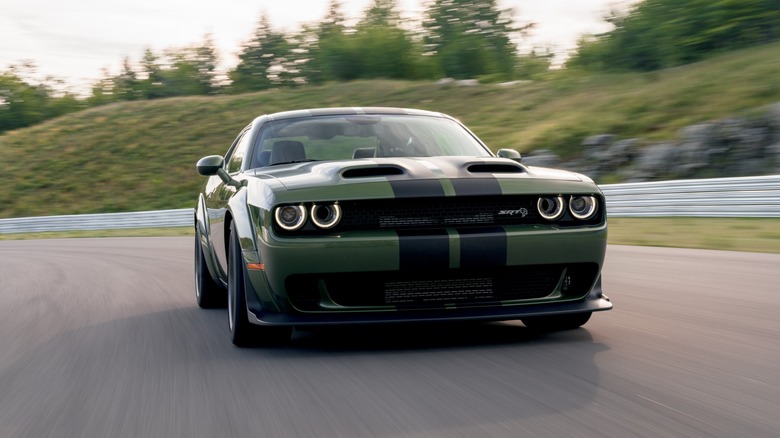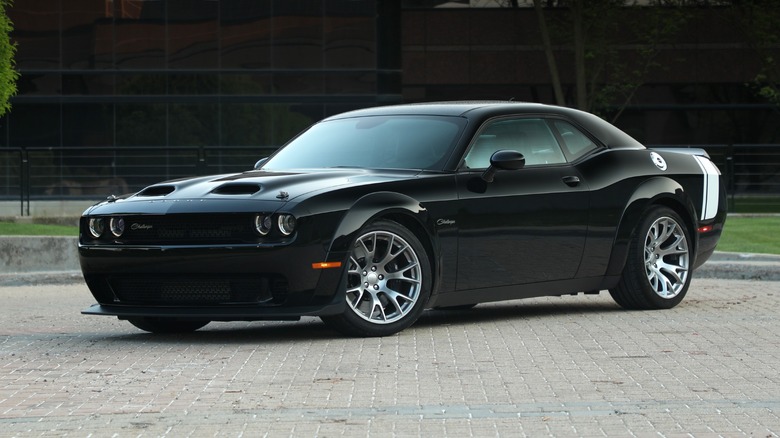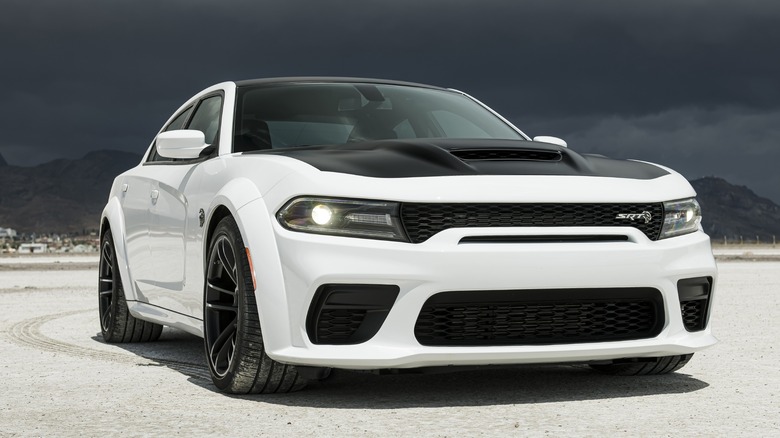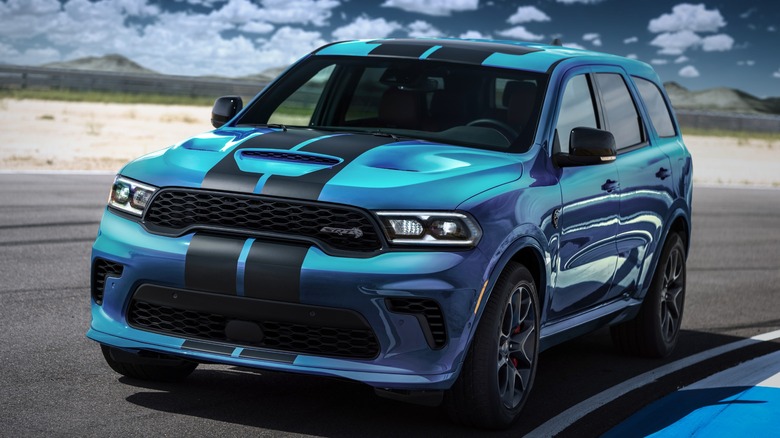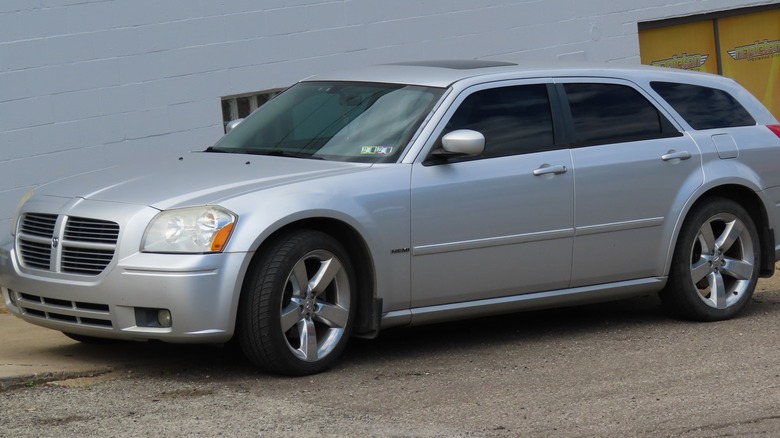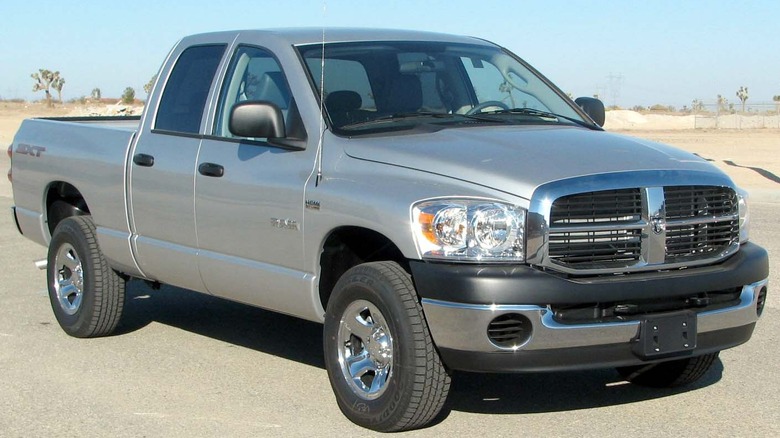Which Dodge Cars & SUVs Have A Gen 3 Hemi Under The Hood?
For fans of V8 engines, it was rather disappointing to learn that Stellantis would be discontinuing its line of Hemi engines after the 2024 model year. These hemispherical engines have been a staple of so many popular vehicles since the early 1950s — first under the name FirePower — but the desire for automakers to make large V8 engines is dwindling due to a push to be more efficient and environmentally conscious. Stellantis is finally moving into the electric vehicle market in the 2025 model year, and beyond that, it is gradually spreading its Hurricane I-6 engine across its brands. There was just no longer space to have Hemis as an option.
Stellantis owns companies like Jeep, Ram, and Chrysler and had been using Hemi V8 engines of various displacement sizes in vehicles from each of those manufacturers. Another company that Stellantis owns where Hemis were widespread is Dodge. With the array of performance vehicles that it makes, Dodge was the perfect place for these impressive V8 engines, and the third and final generation of Hemis found themselves in five different models from the brand.
That may not seem like many, but when you consider all the performance packages that each model offered and that every displacement size Hemi made was an option for at least one of those packages, Dodge was the place to be for a Hemi. So, let's go back to 2003, the first year of the last generation of Hemis, and see just which Dodge vehicles you could get one of those signature hemispherical engines in.
The Challenger
Although the first Dodge Challenger ever made was for the 1970 model year, the muscle car had not been in production for 25 years prior to the revival of its third-generation model in 2008. Dodge brought the Challenger back as the SRT8 model, which is short for Street and Racing Technology, and it started its new life with a 6.1L Hemi V8 underneath the hood, giving it 425 horsepower and 420 lb-ft of torque.
One year later, Dodge would also make the Challenger as an R/T model, indicating a Road and Track performance package, but instead of the 6.1L engine, the company would utilize a 5.7L Hemi V8. Though not quite as powerful as the SRT8 version, the Challenger R/T could still generate 372 horsepower and 401 lb-ft of torque. That comparison point would change rather soon though, because in the 2011 model year, the 6.1L Hemi in the SRT8 was replaced with the even larger 6.4L Hemi that would increase its horsepower and torque to 470 apiece.
The Challenger and Hemi's relationship didn't stop there. Two different 6.2L Hemis were developed: the Hellcat and the Demon. First came the supercharged SRT Hellcat in 2015 that could deliver an astounding 707 horsepower, which would be dwarfed in 2018 with the SRT Demon at 840 horsepower. If you think that's a lot, the 2023 Dodge Challenger SRT Demon could deliver 1,025 horsepower. What a way to go out.
The Charger
Like the Challenger, the Dodge Charger had a hiatus from production for around two decades before the company brought it back in 2006. With its return, Dodge immediately made it part of the Hemi family. However, a Hemi was not the standard engine you were getting with the base model of a 2006 Charger, which would be a 2.7L V6. Instead, you would need to get higher-priced performance packages like the R/T and SRT8 models.
Similar to the Challenger, the R/T model would come with a 5.7L Hemi, and the SRT8 would go for the 6.1L variation. In the body of a Charger, the power output wasn't quite as high for the R/T trim as the Challenger, generating 340 horsepower, but it matched the Challenger with the SRT8 at 425 horsepower. That 6.1L would also be replaced by the 6.4L Hemi and up its output to 470 horsepower, though Dodge would do this for the 2012 model year rather than 2011 as it did with the Challenger.
The Dodge Challenger would be the only model that would receive the Demon variation, but the 2015 model year still saw the Charger get the SRT Hellcat model with a 6.2L Hemi, and in 2021, it would receive a Hellcat Redeye, too. The former would get you 707 horsepower, while the supercharged Redeye increased that to 797 horsepower. Between the Challenger and Charger, Dodge was making some of the fastest production cars on the market, almost regardless of which Hemi was underneath the hood.
The Durango
Hemi engines were not made only for muscle cars. In fact, they were mostly being used for trucks and SUVS, large vehicles that needed a lot of power. You may not immediately associate an SUV with Dodge, as its muscle cars are so flashy, but the midsize Dodge Durango has been part of the Dodge vehicle lineup since the 1998 model year. It may not be among the best-selling SUVs in the United States, but there's clearly still a market for them.
The Durango was rather quick to implement Hemi engines into its options, starting with the 2004 model year that kicked off the vehicle's second generation. The standard engine on most trims of the SUV was a 4.7L V8 from the Magnum-PowerTech line, but the 5.7L Hemi was available as an option for every package, except for the base SXT, which didn't even offer the 4.7L V8 as standard. Instead, it opted for a 3.7L V6. With the Hemi, the Durango could get you 335 horsepower and 370 lb-ft of torque, which is more than satisfying for a large SUV.
In what is perhaps a somewhat surprising move, 2021 saw Dodge give the Durango the SRT Hellcat treatment with the 6.2L Hemi engine. Now, you could take this SUV and kick things up a notch to get an output of 710 horsepower and 645 lb-ft of torque. What was once a solid family vehicle was now a powerful beast.
The Magnum
Every vehicle mentioned thus far is still being made by Dodge, even though future models will no longer have Hemi engines. The mid-2000s saw Dodge reviving old vehicles left and right, and while the Challenger and Charger worked out after decades of being gone, the revival of the Dodge Magnum station wagon for the 2005 model year was not quite as successful as the muscle cars. This was a vehicle that hadn't been in production since 1988, and that was in Mexico. In the United States, it had been gone since 1979 after just two years of production. This revival lasted a tad longer, but the Magnum was discontinued after 2008.
Like the previous vehicles mentioned, the Hemi was available in the Magnum's R/T trim with a 5.7L V8 and the SRT8 trim with a 6.1L V8. These could get you 340 horsepower and 425 horsepower, respectively, placing it right alongside the Challenger and Charger. Unlike those models, the Magnum did not last long enough in production to be given the 6.1L or 6.4L upgrades, but it probably would have if it was still being made. Plus, this is the first of the vehicles to not have a special edition like the Hellcat or Demon. The Magnum station wagon showed up with a Hemi and quietly left not too long after.
[Featured image by MercurySable99 via Wikimedia Commons | Cropped and scaled | CC BY-SA 4.0]
The Ram pickup
Although the Ram truck brand has been its own branch of Chrysler for many years now, it was still part of Dodge back when the third generation of Hemi V8 engines were introduced. Making things all the more important, the Ram pickup trucks were the first vehicles to receive these new engines, starting with the 5.7L Hemi V8, which was an option for the 2003 Dodge Ram 1500. Right off the bat, it would get you 345 horsepower. That engine would also be available for the 2500 and 3500 models in 2003, while the Chassis Cab 3500 would get it as its standard engine in 2007.
The Dodge Ram trucks would not adopt the 6.1L or 6.4L Hemi models; however, that doesn't mean that there wouldn't be a Hellcat available, which hit the scene with the 2021 Ram 1500 TRX. This introduction occurred after Ram had already broken off from Dodge to become its own thing in 2009. However, you may not realize this truck has the Hellcat engine because Ram does not call it as such, as the Hellcat branding remains exclusive to Dodge.
So, while Dodge and Ram were still one brand prior to 2009, only the 5.7L Hemi V8 was ever used in one of its pickup trucks. The Ram 1500 may have been the first to use the third-generation Hemi, but it was also the most limited in terms of available options.
[Featured image by National Highway Traffic Safety Administration via Wikimedia Commons | Cropped and scaled | Public Domain]
